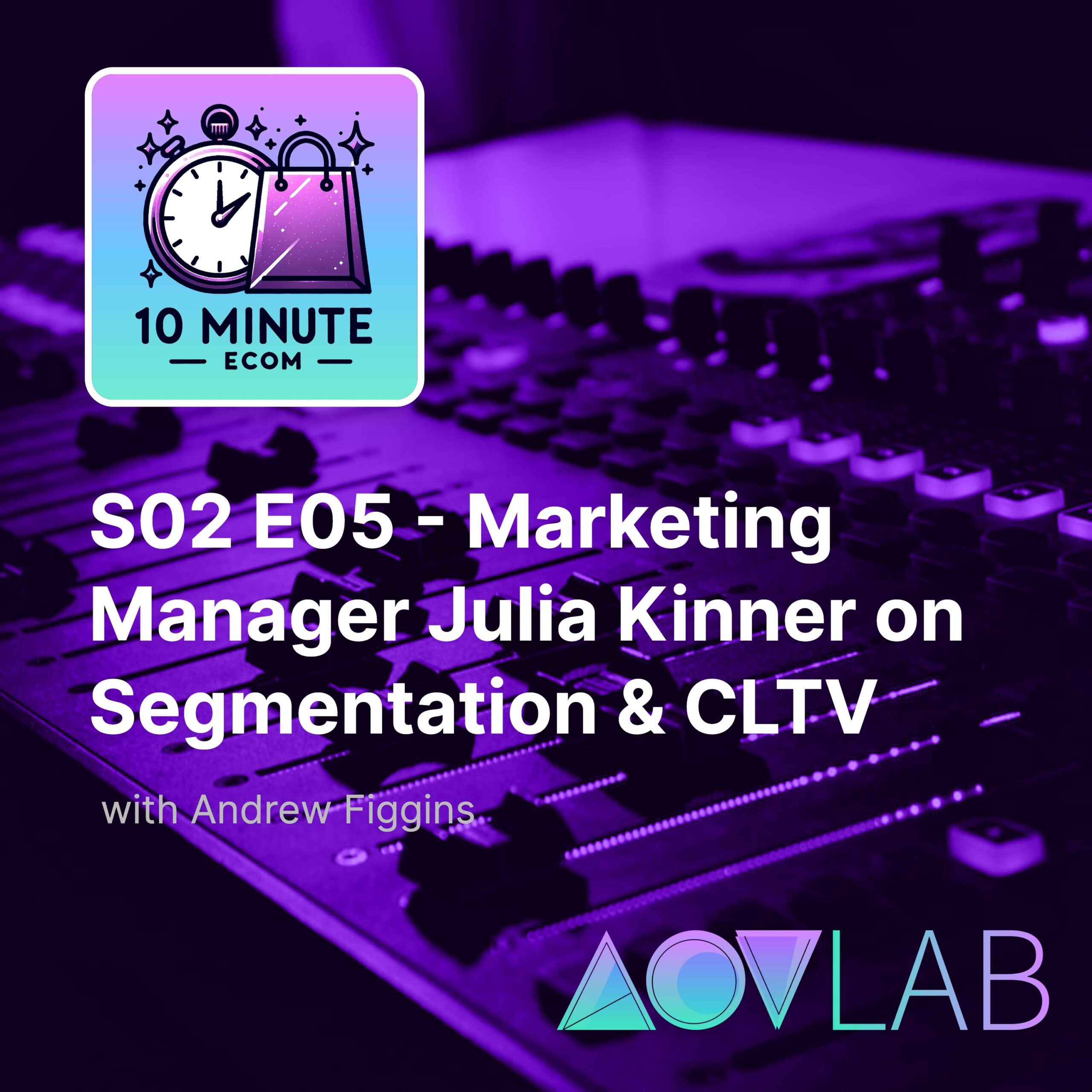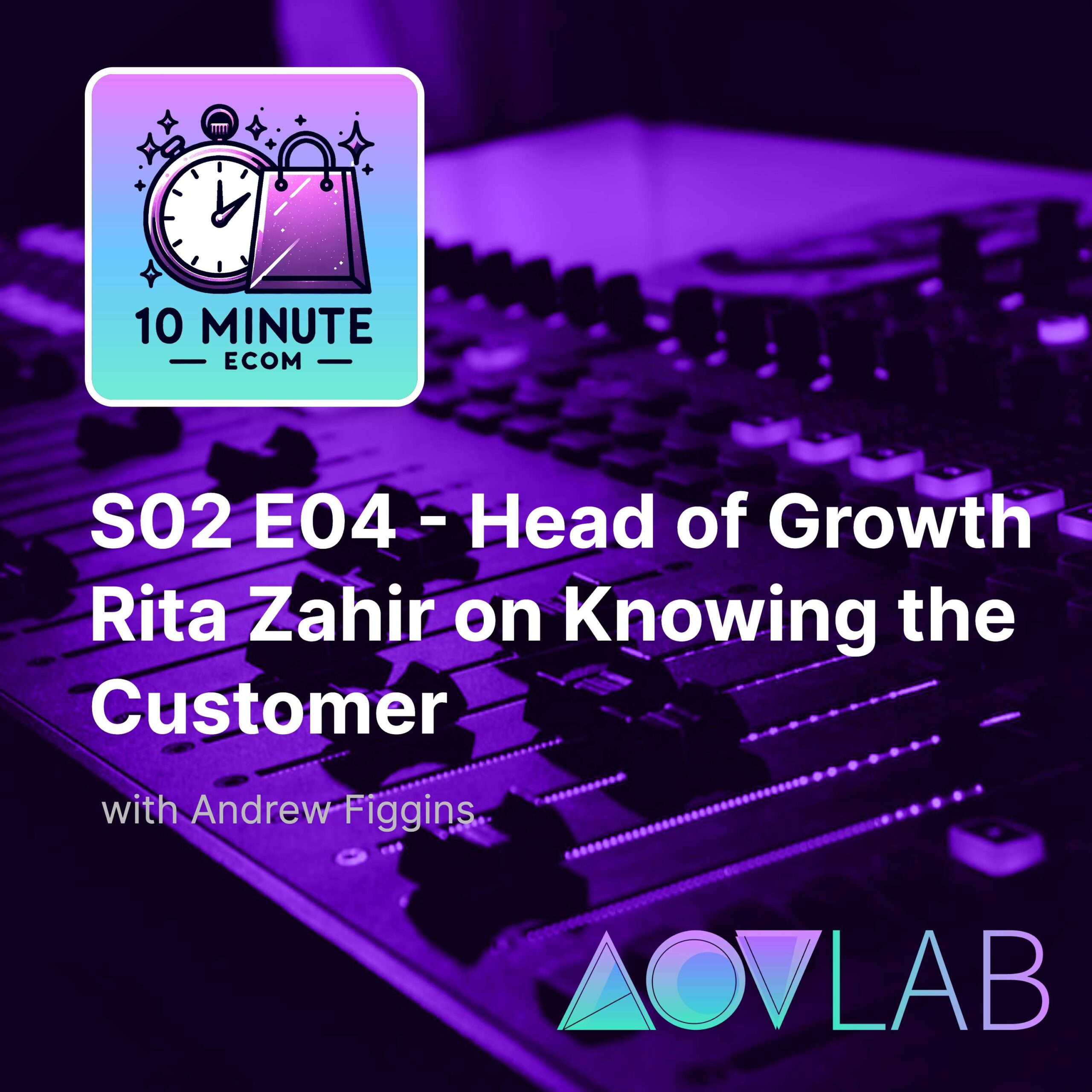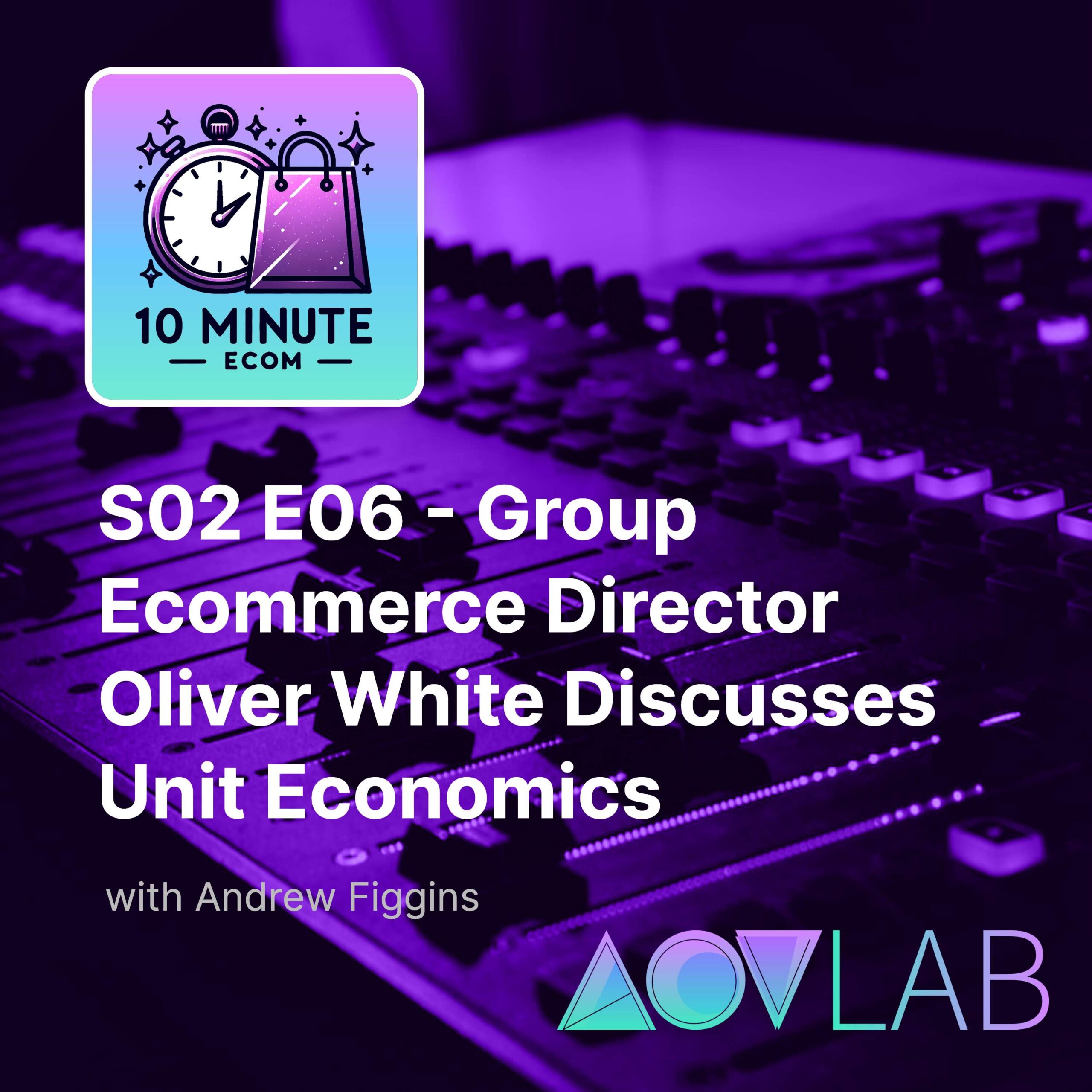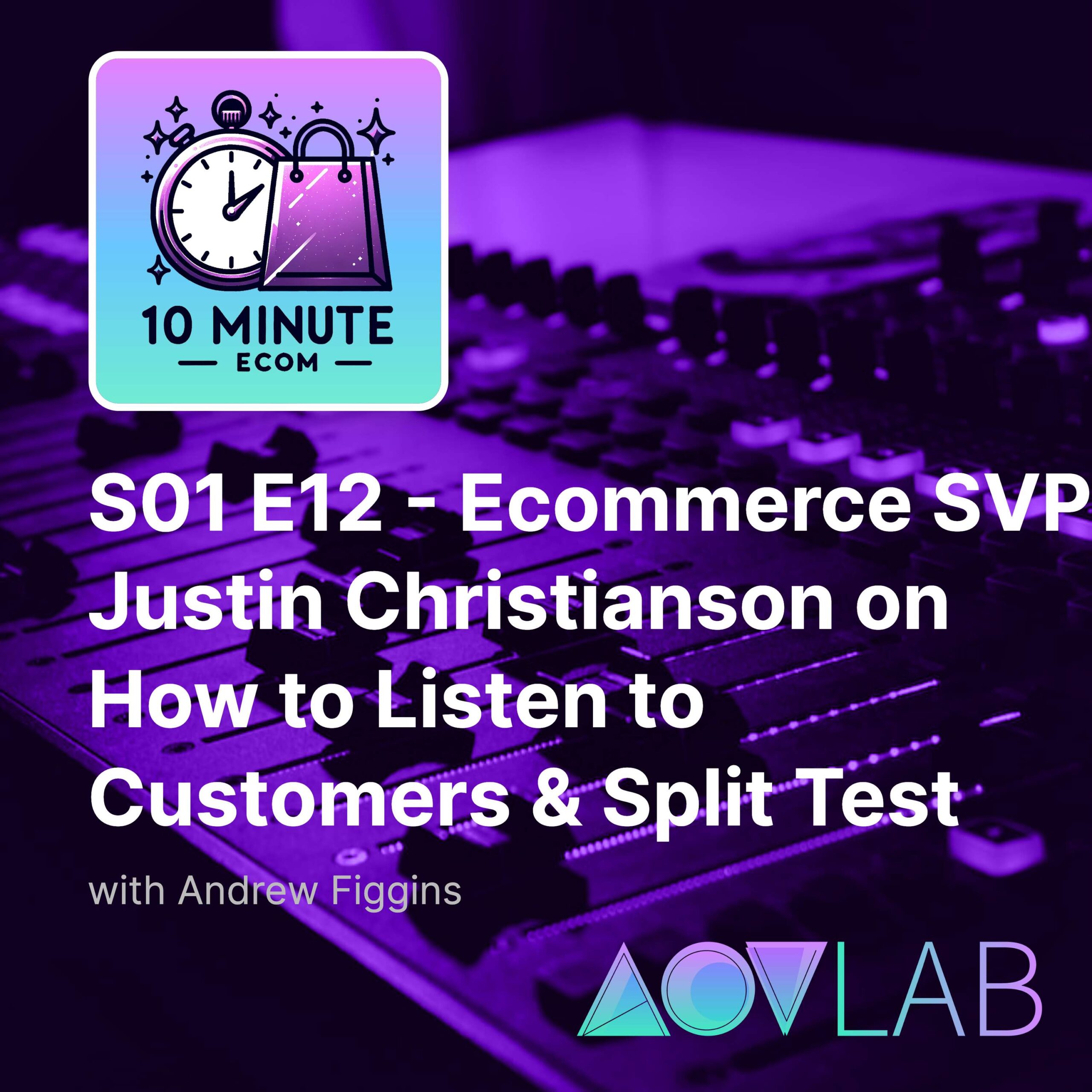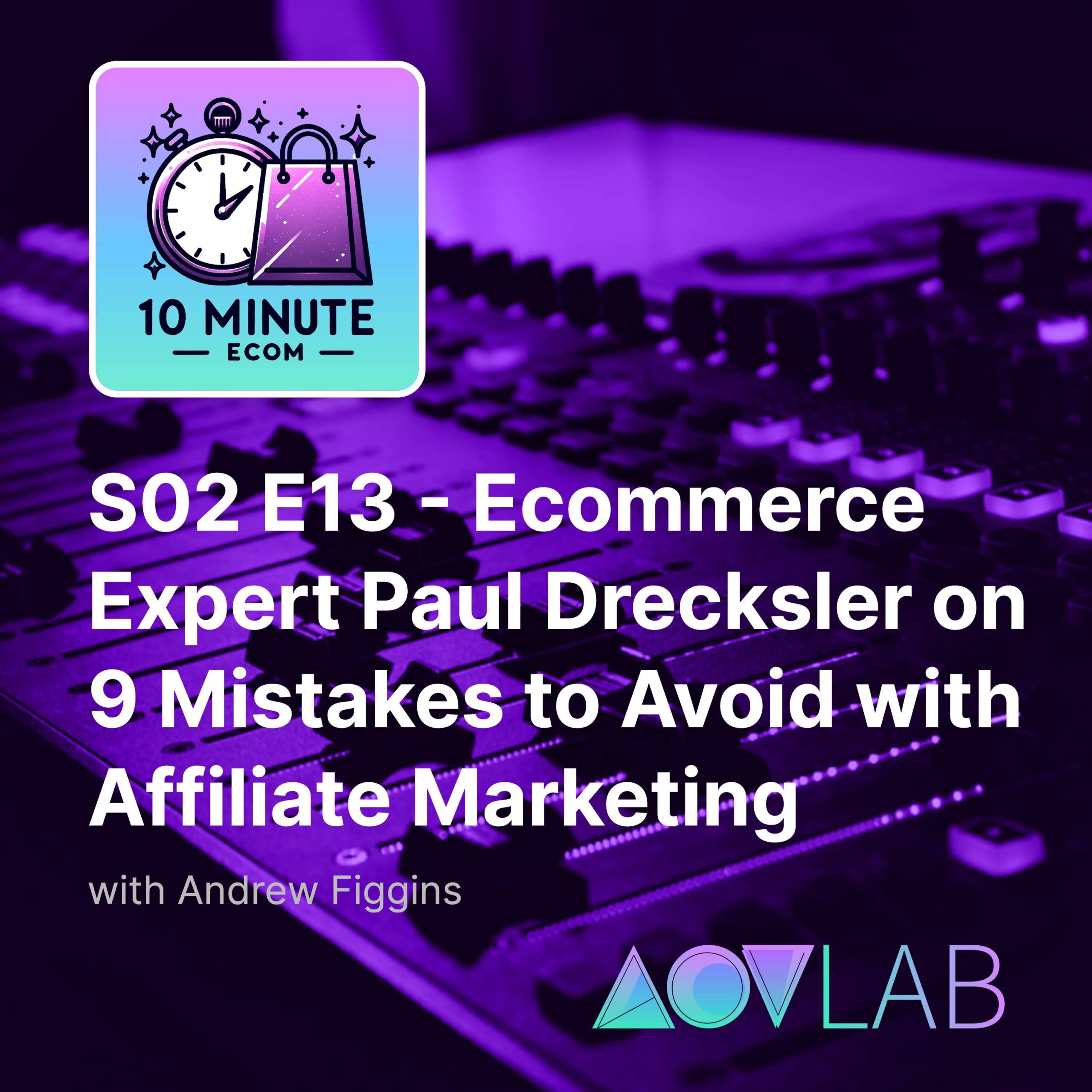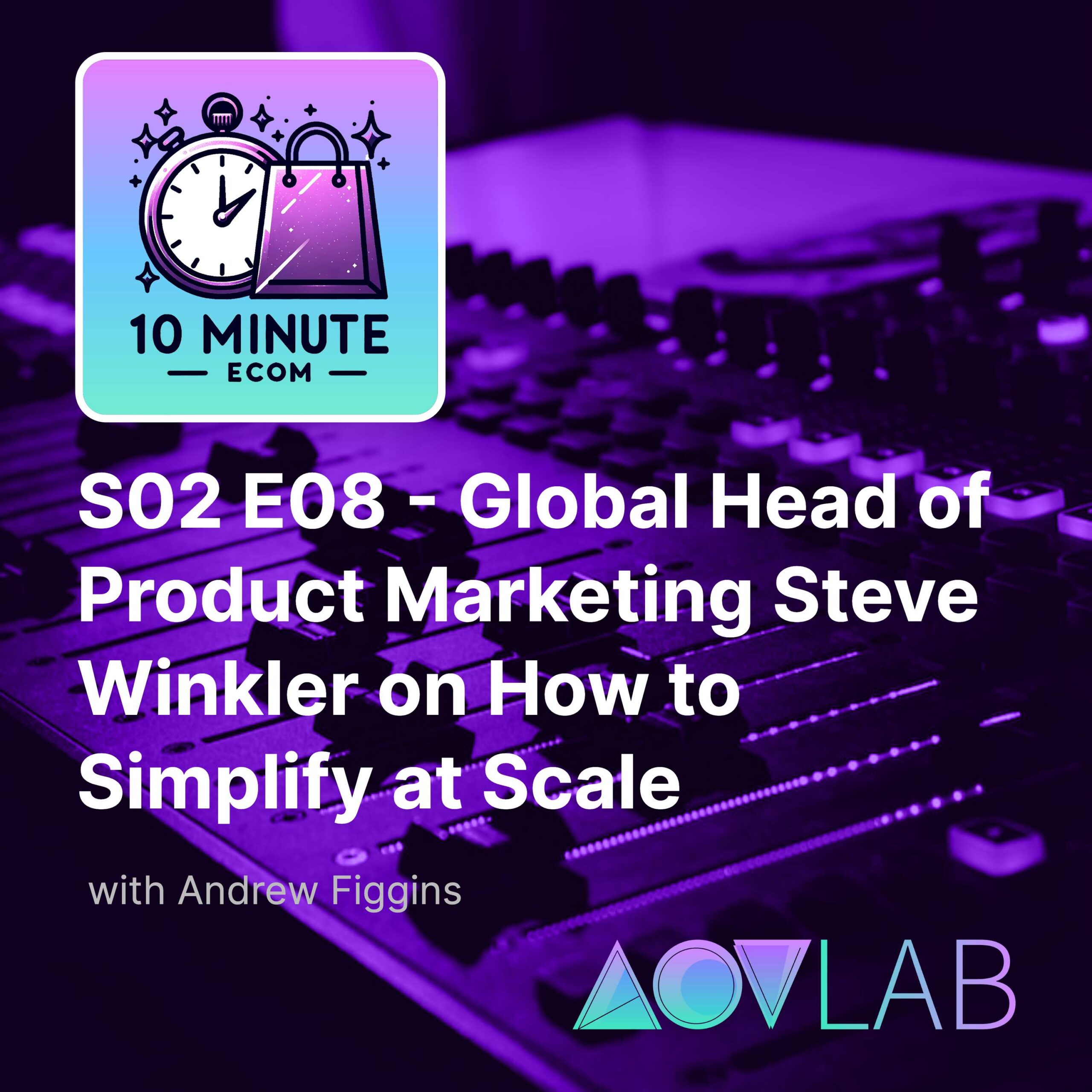View Full Transcript
Episode Transcript
[00:00:07] Speaker A: Hello ecommerce fans, and welcome to ten minute Ecom, an AOV Lab podcast. Every episode we break down a new and different tactic that can help you improve your ecommerce KPIs key performance indicators. I'm your host, Andrew Figgins, and most of you, I am an ecommerce professional. You may know me as the found of AOV Lab, the former vp of product innovation at Scrubs and beyond, or is the former director of e commerce technology at Rural King. Today I'm excited to be talking to Julia Kinna, an e commerce colleague that is doing very interesting work in e commerce. Anyway, Julia, what did you come on the show to share today with your ecommerce colleagues?
[00:00:46] Speaker B: My name is Julia Kinna. I work for my consulting firm JK and associates in Switzerland.
And one thing that I have seen that works in ecommerce is having a very high focus on your customer lifetime value and customer segmentation.
[00:01:04] Speaker A: Thank you, Julia. After the ad, we'll get right into the shop.
Today's episode of ten minute Ecom is brought to you by shop AOV Lab. It is a brand new store with fun apparel and gear specifically for ecommerce professional. Just like you and me, we've got high quality embroidered and printed t shirts, hoodies and hats that will spice up any Zoom call or in person meeting with your team. If you lead a team, these products make for awesome gifts to celebrate hitting a conversion rate or average order value milestone. If you work in ecommerce, I think you'll not only find some humor in these products, but also a sense of pride for what you do every day. Again, the site is shop aovlab.com. Head over right now and browse while you listen. Unless you're driving, in that case, pull over. You've got to see and share these products one last time. The website is Shop AoV Lab.
And now back to the show.
[00:02:09] Speaker C: Julia, welcome to the show today and I'm very excited to talk to you about this topic. It's surprising to me that a lot of brands out there in ecommerce retail, they focus on something other than CLTV or customer lifetime value.
Let's dive right in and start talking about that.
[00:02:27] Speaker B: I'm so happy we talk about this topic today, because if I hear ecommerce, the first thing you will always hear is like, conversion rate optimization. We need to improve our conversion rate and do whatever it takes. And I think there is way too little focus on CLTV. And if we look about CLTV and CAC, they belong together. It's two sides of one equation. And I think there is way too much focus on the CAC side at the moment. But people maybe forget the customer value a little bit. So I'm super excited that we talk about the topic today.
[00:03:03] Speaker C: Yeah, I'm curious what sort of brought you into really thinking about that customer lifetime value? Was there a certain experience that you had or some training or something along the way that sort of got you into really thinking about customer lifetime value?
[00:03:19] Speaker B: This is where I really started my career. So I started in telecommunication and I was in churn prevention and retention. And that's of course a very big topic in telco because if you lose a customer with a very high expected CLTV, that absolutely hurts. So as I spent 5678 years in customer retention and prevention and was doing everything just to optimize the CLTV. And then of course when I moved on and went more into DTC, that is of course still a topic that is very close to my heart. And yeah, that's been it.
[00:03:57] Speaker C: Tell me a little bit about how you approach CLTV. Is it a matter of really starting to separate the type of customers out there that exist in terms of some customers obviously come and maybe they've been offered something so they're one and done or less likely to repeat buy, whereas other customers obviously, or maybe not obviously for either these things, but some customers are loyal, they really like your brand. How do you assemble those segments and how do you think about.
[00:04:27] Speaker B: Yes, that's really the most important and interesting aspect about this because you can look at CLTV, of course, as an average. So I know whatever my average customer has a CLTV of $120. But that's nice because, okay, I have my acquisition cost that is maybe $50. I have my CLTV that is 120. Okay, I'm done. But where things become really interesting is when you start to break down your CLTV segments, because there is good chance that some customers are just more profitable than other customers. And this is where the magic begins. And if you understand who are your most valuable customers, what they have in common? For example, what are the products that they use? Do they have something in common in terms of demographics or channels that you use for acquisition? Then you can use your CLTV segmentation to ultimately steer your acquisition strategy. And I think this is where it's really interesting because what I see at the moment is that a lot of businesses, on the one hand they have acquisition, on the other hand they have the value management. But those two are, they don't talk to each other. So it's not an integrated approach so far. So what we said, you have to segment your base and then this segmentation has to find its way into your acquisition strategy.
[00:05:52] Speaker C: It makes a lot of sense to really be paying attention on trying to acquire those loyal customers, those high CLTV customers. Do you have an approach that you take to try to find those customers that over time are going to prove out to be higher CLTV?
[00:06:11] Speaker B: There are two ways to go about it. First, you can analyze your internal data if you have the data. So it depends a bit on your data strategy and the data you have at hand if you can do it, because of course that only makes sense if it is actionable at the end of the day. So you need to have the data that allows you to translate your finding into an acquisition strategy because otherwise it's a nice exercise. But what do you do at the end of the day? So one is the internal analysis, or the second way is to do an external market research so that you really try to understand with external data in a quantitative study, who are the customers that have the highest interest in the product, that have the highest consumption frequency, the highest intent to pay? So I see basically two ways to go about it, depending on the situation.
[00:07:11] Speaker C: Of the company, of course I see. Do you think this is something that really paying attention to customer lifetime value?
Does it make sense across the board whether you're a small ecommerce company just starting out, or whether you're a $20 million a year business, or even 100 million or even a billion dollars in business? Or do you think that the strategy just applies maybe to one end of the spectrum?
[00:07:39] Speaker B: No, I think a solid view on your customer lifetime value, not only as an average, but really in a more segmented way, can help any business to fine tune their acquisition strategy if they do it in the right way. And I would even dare to say that a lot of small businesses will struggle to grow profitably if they don't do it. Because what is it that we see at the moment? Acquisition cost is on the rise. You have more and more competition in the market. It's hard to get noticed on social media platforms. So I think a lot of businesses will have to look at that because it's the only way to grow profitably.
[00:08:25] Speaker C: Absolutely.
Do you have any tools that you use for these tasks, whether it's the segmentation aspect or even on site, how you start to communicate to customers around things like loyalty and repeat purchase.
[00:08:42] Speaker B: In terms of tools that you use for the segmentation, it's just any data tool that you can use not so sure I understood the second part of the question.
[00:08:50] Speaker C: Yeah, I think it was a poorly formed question, because I think the answer was probably like, hey, man, if you have a spreadsheet, you're good to go. So, Julia, let's assume the business has access to a spreadsheet, and if they do, can you share maybe an example from some of the work you've been doing with clients? Do you have an example that maybe you could share with us of how you've been able to achieve some higher CLTV?
[00:09:19] Speaker B: Yes, absolutely. So I had one client. Exactly. A funny story, because quite typically, they were reaching out because they wanted to reduce their CPA. They had some TikTok campaigns running, and that was not running as very great. And so they were actually trying to optimize their campaign. But what they didn't look at and what we worked on together was to really understand what are their most profitable customers. So in that case, they had, like, offers for professionals, just for beginners and so on. And so we were breaking down the CLTV based on the courses. And that, of course, helped to fine tune, first, the assets that you use for your acquisition campaigns, because it's very dedicated to the target group that you want to target. And secondly, just target the audiences that, on the long run, have a higher CRTV.
[00:10:17] Speaker C: Excellent. I think that in some cases, in some of the US based e commerce businesses, I've seen, CLTV comes along last. But I think what you're saying today, Julia, is it really needs to come first because it dictates so much.
[00:10:32] Speaker B: Yeah, maybe not first. I think it's just part. It's part of one big story. At the end of the day, a business wants to grow profitably, and that means that you have to generate value with your customers on the long run. And truth is, there are just customers that are more profitable than others. So why spending your hard earned money on the guys who have a very low CLTV?
[00:10:57] Speaker C: Excellent, Julia. It is ten minute ecom. It's a brief conversation. We don't have a lot of time left today, but I wanted to ask you, before we head off, is there anything else that you'd like to share with your ecommerce colleagues that are listening today?
[00:11:11] Speaker B: I think definitely think about your CLTV. Think about how you have to define your acquisition strategy to really target your most loyal customers. And, of course, that doesn't mean that you don't want customers that are maybe a little less profitable, but I think the focus should really be to focus on high value segments.
[00:11:36] Speaker C: Thanks again, so much Julia, for coming on the show today. It was a pleasure meeting you and talking to you. Thank you.
[00:11:40] Speaker B: Yeah, it was great. Thanks for having me, Andrew.
[00:11:43] Speaker C: Well, we have hit that ten minute.
[00:11:45] Speaker A: Mark, so that's a wrap for today's episode. I want to again thank our guest, Julia Kinner. If you have a moment, be sure to subscribe like or follow the show on Apple Podcasts, Spotify, Amazon Music, Google Podcasts, or wherever it is that you listen. As mentioned earlier in the episode, please head on over to shop AOV Lablab.com, our brand new store that helps to support this podcast. It is launching with nearly 100 products, so plenty to choose from.
[00:12:14] Speaker C: Our top seller so far is a.
[00:12:16] Speaker A: Shirt that simply says Ecom on it. I wear it around my extended family so I can point to it when my relatives ask me what I do.
I hope you enjoyed this episode of the show. Until next time, this is Andrew Figgins signing off and saying have a good one.
